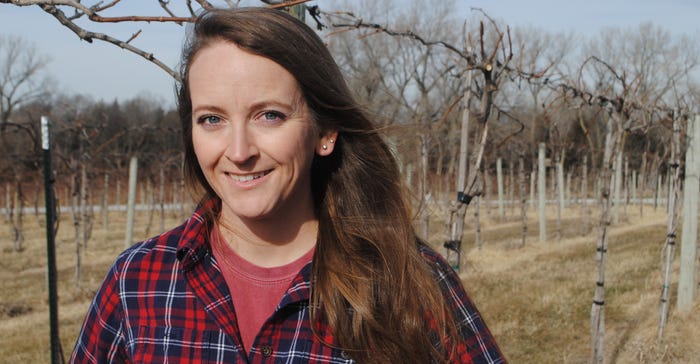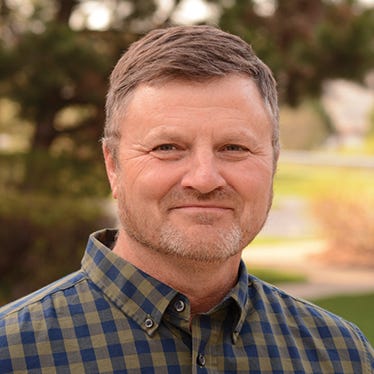
A love of horticulture and a deep desire to return to the family farm near Prague, Neb., led Kara Sousek, president of the Nebraska Winery and Grape Growers Association, on an adventure that today involves caring for 12.5 acres of grapevines through her Hundred Hills Vineyards operation.
With about 36 wineries operating in the state, Sousek is quick to point out that she believes the state is ripe for more vineyards and wineries. At the University of Nebraska-Lincoln, Sousek majored in horticulture with a minor in the innovative Engler Entrepreneurship program.
“Going in, I didn’t know exactly where horticulture would take me,” Sousek says. “I had always figured I might go back to the family farm and start something there. After my sophomore year at UNL, I received an email through the horticulture department about a vineyard north of Lincoln that was looking for summer help, and ideally, someone that was interested in staying with the vineyard after graduation. I applied, got the job and did just that.”
Vineyard life
Sousek worked at that vineyard every summer and for a few hours a week through the winter and spring months. She graduated from UNL in December 2016 and started full time at the vineyard.
“That same spring after graduation, I also planted my first acre of grapes on the family farm by Prague,” Sousek says. “In 2019, the owner of the vineyard I was working for decided to retire, so I took on a lease agreement with him to continue farming the vineyard on my own.”
Between the 10 acres at that vineyard and 2.5 acres at the farm in Prague, Sousek is kept busy using her horticulture training. The vineyards are named “Hundred Hills” because that is the name Sousek’s grandfather, Frank, gave the beautiful hills surrounding Prague.
“My brother-in-law, Sam Creal, and I manage the vineyards together, with him operating most of the mechanical tasks and maintaining the equipment, and I am making the viticultural decisions and tending the vines by hand,” Sousek says. “The grapes are sold to nearby James Arthur at Raymond and Cellar 426 at Ashland, and occasionally a few others, depending on our supplies.
“We own a New Holland Braud grape harvester, which we use to harvest our own vines, as well as do some custom harvesting for other vineyards and wineries that rely on mechanical harvesting.”
The mechanical harvester makes an operation that would take 30 people about four hours to do by hand take only two hours with four people.
Harvesttime is one of the most rewarding aspects of the business for Sousek. “Harvesting grapes from vines that you, yourself, have planted is very rewarding,” she says, “since it takes three years before you get a crop off newly planted vines and five to six years to reach full production.” The plan is to eventually get to 20 acres of grapes by planting new vines every year.
Cash flow
“While growing the vineyard business and investing in essential machinery, I’ve always aimed to cash flow as much as possible,” Sousek says. “Because of this, I’ve kept a day job in addition to managing the vineyards, which means that I haven’t had as much time to spend in the vineyards as I would like.”
She has worked for Great Plains Nursery near Weston, Neb. for the past two years. “This has been a tremendous blessing, because they have been very flexible in letting me take off time for grape harvest, and I’ve learned so much from the folks there in how to run a successful business,” Sousek says.
Eventually, Sousek will transition to full time to the vineyards, but she has learned to balance her time and make the most of work time in an effective manner. For instance, while many vineyard operators like to prune vines beginning in March, Sousek makes it a winter job, even in the coldest of conditions, so she can get the job completed by spring.
There is an art to pruning, Sousek says. Heavy pruning can help to lower crop yield but improve quality, while light pruning boosts growth and production for specific varieties.
Looking to the future, Sousek hopes to perhaps open a winery one day, but she says that she also wouldn’t mind remaining a grower, focused on growing the best quality grapes she can, delivering them to wineries and enjoying the fruits of the labor.
Most Nebraska vineyards plant a mixture of hardy French-American varieties such as Edelweiss, Frontenac, St. Croix and La Crosse. Right now, Sousek is excited about a relatively new red variety — Petite Pearl — that she planted in the vineyard and will get a first harvest from in 2022.
“Early in my career, I had the pleasure of meeting the grape breeder who bred that variety at one of our NWGGA conferences,” she says.
As Nebraska wineries have tried many different varieties over the years to see what grows best for them at their location and what produces the wine that they are aiming for, Petite Pearl has risen to the top of the list, Sousek says. “It has excellent growth habits that make it easy to maintain, and it makes excellent wines either as stand-alone varietal or blended with other red varieties.”
Engler angle
The business all started with Engler, because the program was influential with Sousek, helping her to look at big-picture planning as well as difficult skills that she needed to organize a business.
“The classes I took taught the essential financial knowledge I needed,” she says. “Not being particularly knowledgeable in math and finances, it took me a while to grasp basic things like balance sheets, and profit and loss statements, but practicing on business plans in college made it much easier to do in my own business later on.”
Even more importantly, Engler challenged Sousek on philosophical questions like, “What is your why?” and “What does entrepreneurship mean to you?” Answering these questions emboldened Sousek to pursue her own passion and purpose, which landed her in the vineyard business.
She acknowledges several mentors during her journey, including Paul Read and Steve Gamet from UNL’s viticulture program, Eric Nelson, and the Nebraska pioneering wineries of the 1990s such as James Arthur and others. “They showed us that it can be done,” she says.
Sousek sees a huge potential for growth in Nebraska vineyards, not only on her own farm, but also all across the state.
“I believe that I am here to show Nebraska agriculture that it still can be done. It is a sustainable venture, and a viable diversified crop that adds value to your community and to Nebraska as a whole,” she adds.
Learn more about Nebraska vineyards and wineries at nebraskawines.com.
Read more about:
Next GenerationAbout the Author(s)
You May Also Like






